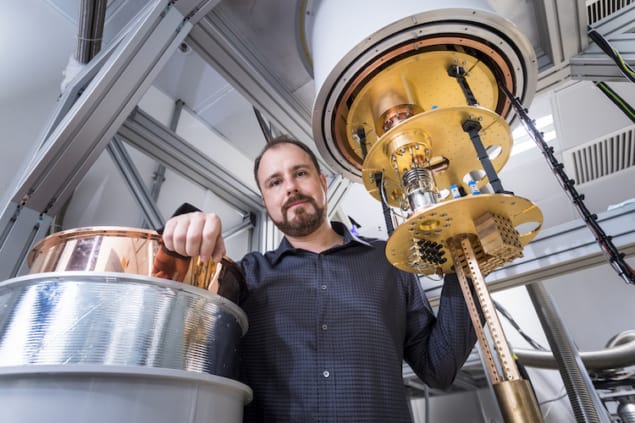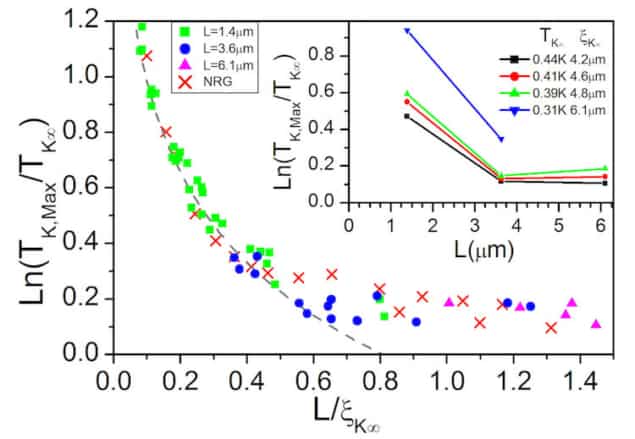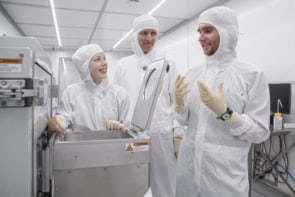
The first experimental measurement of a Kondo cloud – a condensed-matter phenomenon that drastically increases the electrical resistance of certain metals at low temperatures – confirms that this long-predicted structure really exists, more than half a century after it was first hypothesized. The new measurement could improve our understanding of condensed-matter systems that contain multiple magnetic impurities, including high transition-temperature superconductors.
In the 1930s, physicists spotted a surprising trend in the electrical resistance of metals that contain magnetic impurities. Unlike metals without such impurities, electrical resistance increases rapidly once the temperature drops below a certain threshold – and then keeps increasing as the temperature drops further.
The phenomenon was not explained until 1964, when the Japanese theorist Jun Kondo showed that at low temperatures, the spin of a magnetic impurity collectively couples, or becomes “stuck”, to all the electrons in the area. The resulting cloud of spin-coupled electrons – the Kondo cloud – screens off the conducting electrons and prevents them from moving. The result is an increase in the metal’s resistance.
Isolating a Kondo cloud
Although the spins interact locally with electrons around the magnetic impurity, the Kondo cloud can, in theory, spread out over several microns. This prediction inspired a team of researchers from Japan’s RIKEN Center for Emergent Matter Science, City University of Hong Kong, Korea Advanced Institute of Science and Technology (KAIST), the University of Tokyo, and Ruhr-University Bochum in Germany to try to measure the length of a Kondo cloud in a related system: the tiny pieces of semiconducting material known as quantum dots (QDs). Here, an unpaired electron spin trapped in the dot plays the role of a magnetic impurity in a metal.
In their work, the researchers fabricated a QD and connected it to a long, one-dimensional channel that houses a Fabry-Pérot interferometer containing an electron reservoir. When the unpaired electron spins in the QD couple to the electrons in this channel, a Kondo cloud forms. “In this way, we isolate a single Kondo cloud around a single impurity and can control the size of the cloud as well,” explains study lead author Ivan Borzenets.
The researchers applied varying voltages at different points along the channel to induce weak barriers along it. They then observed how the channel’s electrical conductivity and the Kondo temperature – a quantity inversely proportional to the length of the Kondo cloud, and fairly straightforward to measure – changed as a function of the barrier strength and position.

“When we place a perturbation (a weak barrier) in our 1D channel, at a controlled length away from the magnetic impurity, and then activate this perturbation, this results in a change in the measured Kondo temperature,” Borzenets tells Physics World. “If the perturbation is at a length that is within the Kondo cloud, the Kondo temperature is strongly affected. Conversely, if it is outside the cloud, the effect is very small.”
The results showed that oscillations in conductance coincided with oscillations in the measured Kondo temperature. By plotting the amplitude of the Kondo temperature oscillation against the distance between the barrier and the impurity divided by the theoretical cloud length, the team found that all their data points fell onto a single curve, just as predicted (see graph).

Quantum oscillations appear in a Kondo insulator
Proportionality factor
The team say they have unequivocally proved the existence of the Kondo cloud by directly measuring its length. They also identified the proportionality factor that relates the size of the cloud to the Kondo temperature. They now plan to study more complicated Kondo systems containing multiple impurities.
“For example, we could place two impurities in the quantum dot at the same time and observe how they react when the clouds overlap,” Borzenets says. “The results from these experiments should provide important insights into the behaviour of multiple impurity systems, such as Kondo lattices, spin glasses and high transition-temperature superconductors.”
“It is very satisfying to have been able to obtain real space images of the Kondo cloud, as it is a real breakthrough for understanding various systems containing multiple magnetic impurities,” adds team leader Michihisa Yamamoto. “This achievement was only made possible by close collaboration with theorists.”
Heung-Sun Sim, the KAIST theorist who proposed the method for detecting the Kondo cloud, agrees: “It is remarkable from a fundamental and technical point of view that such a large quantum object can now be created, controlled, and detected.”
The research is detailed in Nature.



